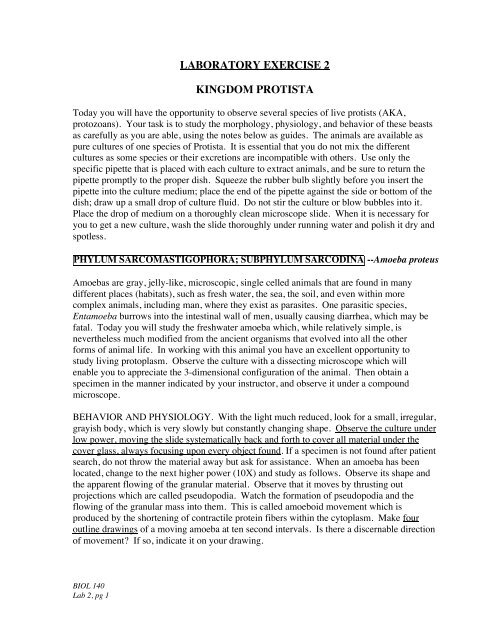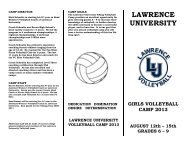LABORATORY EXERCISE 2 KINGDOM PROTISTA
LABORATORY EXERCISE 2 KINGDOM PROTISTA
LABORATORY EXERCISE 2 KINGDOM PROTISTA
You also want an ePaper? Increase the reach of your titles
YUMPU automatically turns print PDFs into web optimized ePapers that Google loves.
<strong>LABORATORY</strong> <strong>EXERCISE</strong> 2<strong>KINGDOM</strong> <strong>PROTISTA</strong>Today you will have the opportunity to observe several species of live protists (AKA,protozoans). Your task is to study the morphology, physiology, and behavior of these beastsas carefully as you are able, using the notes below as guides. The animals are available aspure cultures of one species of Protista. It is essential that you do not mix the differentcultures as some species or their excretions are incompatible with others. Use only thespecific pipette that is placed with each culture to extract animals, and be sure to return thepipette promptly to the proper dish. Squeeze the rubber bulb slightly before you insert thepipette into the culture medium; place the end of the pipette against the side or bottom of thedish; draw up a small drop of culture fluid. Do not stir the culture or blow bubbles into it.Place the drop of medium on a thoroughly clean microscope slide. When it is necessary foryou to get a new culture, wash the slide thoroughly under running water and polish it dry andspotless.PHYLUM SARCOMASTIGOPHORA; SUBPHYLUM SARCODINA --Amoeba proteusAmoebas are gray, jelly-like, microscopic, single celled animals that are found in manydifferent places (habitats), such as fresh water, the sea, the soil, and even within morecomplex animals, including man, where they exist as parasites. One parasitic species,Entamoeba burrows into the intestinal wall of men, usually causing diarrhea, which may befatal. Today you will study the freshwater amoeba which, while relatively simple, isnevertheless much modified from the ancient organisms that evolved into all the otherforms of animal life. In working with this animal you have an excellent opportunity tostudy living protoplasm. Observe the culture with a dissecting microscope which willenable you to appreciate the 3-dimensional configuration of the animal. Then obtain aspecimen in the manner indicated by your instructor, and observe it under a compoundmicroscope.BEHAVIOR AND PHYSIOLOGY. With the light much reduced, look for a small, irregular,grayish body, which is very slowly but constantly changing shape. Observe the culture underlow power, moving the slide systematically back and forth to cover all material under thecover glass, always focusing upon every object found. If a specimen is not found after patientsearch, do not throw the material away but ask for assistance. When an amoeba has beenlocated, change to the next higher power (10X) and study as follows. Observe its shape andthe apparent flowing of the granular material. Observe that it moves by thrusting outprojections which are called pseudopodia. Watch the formation of pseudopodia and theflowing of the granular mass into them. This is called amoeboid movement which isproduced by the shortening of contractile protein fibers within the cytoplasm. Make fouroutline drawings of a moving amoeba at ten second intervals. Is there a discernable directionof movement? If so, indicate it on your drawing.BIOL 140Lab 2, pg 1
STRUCTURE. Under high power (40 + x), note the clear outer region of the protoplasm, theectoplasm. The surface of the ectoplasm in contact with the water constitutes the cellmembrane, the familiar plasma membrane that shows as two electron dense layers around aless dense area in electron micrographs. The inner granular material is called endoplasm. Itis not sharply separated from the ectoplasm, but is distinguishable, due to its more granularnature. The nucleus, a round or ovoid finely granulated body, may be found in theendoplasm. It is lighter in color and clearer than the surrounding protoplasm. The nucleus isdifficult to observe in small specimens. Sometimes it is concealed by other material, and astained slide must be studied in order to observe it. In what general region is it found? Nearthe nucleus may be found a small, spherical, transparent vesicle which upon reaching acertain size contracts and disappears. This is the contractile vacuole. Its primary function isto eliminate the excess water which continuously diffuses into the organism, and secondarilyto excrete some waste substances. Observe its formation and note the interval betweensuccessive contractions. A food vacuole is composed of a food particle surrounded by water,into which have been secreted enzymes from the surrounding cytoplasm. The food soonbegins to undergo digestion, owing to the action of enzymes on it. The cytoplasm includeseverything except the nucleus. Draw an amoeba approximately 2-3 inches in length andlabel all structures.REPRODUCTION. The amoeba reproduces by fission, a simple process of dividing intotwo amoebas. The nucleus divides, and the cytoplasm constricts until the parent animal isdivided into two "daughter" amoebas.PREPARED MATERIAL. Obtain stained preparations of amoebae, and identify all thestructuresPHYLUM CILIOPHORA --Paramecium caudatumCiliates are distinguished by the presence of cilia, which are hair like outgrowths ofprotoplasm extending from the surface of the cell. They serve in locomotion and feeding.These minute structures are also found in man, in nasal passages, in the trachea, and in otherparts of the body. While some of the ciliates such as Paramecium caudatum are perfectlyharmless animals, there are others which are endoparasites of man. The ciliate Balantidiumcoli lives in the human intestines and may produce dysentery severe enough to cause death.The paramecium not only serves as a good type for the study of a ciliate, but also it is a goodexample of a more complex protozoan. It is a favorable form with which to illustratecyclosis and other physiological processes of single-celled animals.BEHAVIOR. Place a drop of paramecium culture on a slide and observe the animalsswimming freely. Can you distinguish anterior from posterior in this animal? Dorsal fromventral? Do they move in any one direction more than another? Turn off the powerilluminator on the microscope and place a light on one side of the drop. How does this affectBIOL 140Lab 2, pg 2
the behavior? Add a few fibers stripped from the edge of a sheet of lens paper to the drop.How do paramecia react when they encounter such barriers?STRUCTURE. On a clean slide make a ring of distilled water—methylcellulose solutionwhich is 1/8 inch wide and whose diameter is a little less than the width of a cover glass.Place a drop of paramecium culture in the center of the ring. Then dip a dissection needlenot more than l/4 inch into a mixture of yeast and Congo red dye, and add a small mass ofthis mixture to the ringed culture. Do not tease out the clump of yeast which you have addedto the culture. Lay on a cover glass.The outer layer of the paramecium is called ectoplasm, the surface of which is differentiatedas a firm membrane, the pellicle. The endoplasm is the inner, granular, and more fluidportion of the cytoplasm, and contains a variety of organelles, such as nuclei and contractilevacuoles located near each end. When they become filled, they discharge their liquidcontents to the exterior. Do they contract alternately, at the same time, or irregularly? Whatis the time interval between successive contractions of the same vacuole? In somepreparations, the radiating canals which are associated with the development of a contractilevacuole may even be seen.Most species of paramecia have two nuclei; the large oval macronucleus is located near themiddle of the body, and controls nonreproductive functions. The much smaller micronucleuslies close by the side of the macronucleus, and mediates reproductive processes.On the oral surface and running obliquely from the anterior end to about the middle of thebody is a concave, somewhat funnel-shaped, depression, the oral groove. The oral grooveleads into the cell gullet by way of the cell mouth. Constantly moving cilia sweep foodparticles down the oral groove and into the gullet. The mouth is the entrance to the gullet,and is located at the posterior end of the oral groove. Food vacuoles form at the inner end ofthe gullet; they appear as drops of water containing food particles. The cell "anus" is locatedabout midway between the mouth and the posterior end of the body. It is a temporaryopening which forms only when undigested particles are discharged. Nitrogenous wastes,chiefly ammonia, pass out of the cell by diffusion.DIGESTION. Food is digested by the action of enzymes secreted from the cytoplasm intothe food vacuoles. Different enzymes act best in an acid, or an alkaline, or a neutral medium;consequently, the paramecium must not only produce enzymes for the digestion of food, butalso it must also furnish these enzymes with the optimal pH. In the food vacuoles of theparamecium, the reaction is at first acid, but later it becomes alkaline. One of the mostimportant enzymes, the protein-digesting enzyme of the paramecium, acts only in an alkalinemedium.Congo red becomes blue in acid solutions (pH 3.0 or below) and red in less acid solutions(pH 5.0 or above). What color is the food vacuole when it is first formed? What color doesit change to? What are the subsequent color changes? What is the significance of thesechanges in color of the food vacuole?BIOL 140Lab 2, pg 3
After about one-half hour, observe the pattern the food vacuoles made in the body of theparamecium. Can you distinguish between the younger and older food vacuoles? Do thefood vacuoles decrease in size as they travel in the body of the paramecium? How do theychange in position with time? Explain!WATER BALANCE. With the people at each side of a table acting as a research team, setup the following demonstration: Make four different preparations of paramecium culture andmethylcellulose and observe the behavior of the contractile vacuole simultaneously,recording the number of contractions per minute in each. The preparations are:A. 1 drop culture & 1 drop methylcellulose solution.B. 1 drop culture & 1 drop methylcellulose solution with 1% NaCl.C. 1 drop culture & 1 drop methylcellulose solution with 2% NaCl.D. 1 drop culture & 1 drop methylcellulose solution with 4% NaCl.You should try to keep the drop sizes approximately equal in all parts of this demonstration.Why? Does this constitute a scientific experiment? Why? How does the behavior of thevacuole in these media help explain its function? Would you expect marine protozoa topossess a contractile vacuole? Why?TRICHOCYSTS. Embedded in the ectoplasm just beneath the pellicle, are oval shapedbodies called trichocysts; these are best seen in a prepared slide. If the paramecium isirritated, these trichocysts are discharged in the form of long threads. They may serve asinstruments of defense or for attachment while the animal is feeding. Add a drop of ink to afresh culture on a slide. Observe the discharged trichocysts under high power. Preparedslides are also available showing these structures.REPRODUCTION. Paramecia divide asexually in a manner similar to amoebae; and inaddition, they possess a means for sexual reproduction termed conjugation. On preparedslides, observe the paramecia undergoing fission and conjugation and understand what isoccurring in each case. Why should an animal have both a sexual and an asexual means ofreproduction? What is the significance of each type?PREPARED MATERIAL. Obtain stained preparations of paramecia, and identify all thestructures. Draw a composite sketch of a paramecium showing and identifying all of thestructures you observed in living and prepared specimens.BIOL 140Lab 2, pg 4



